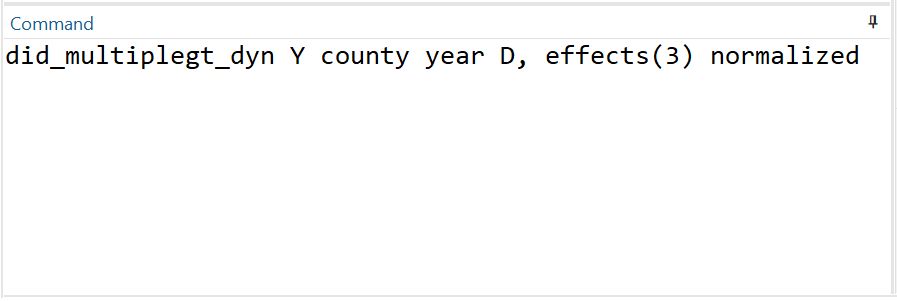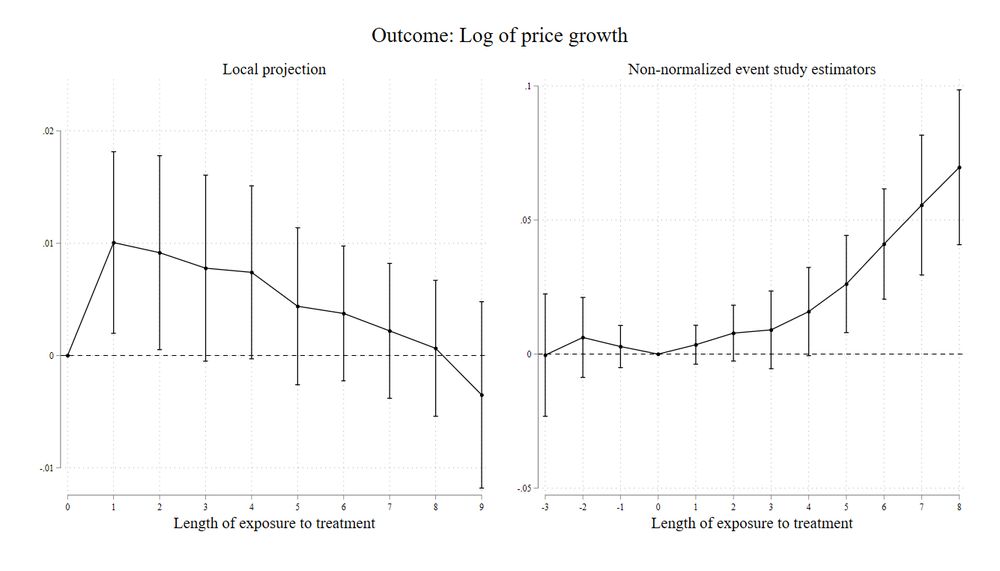Clément de Chaisemartin
@cdechaisemartin.bsky.social
Professor @sciencespo @ScPoEcon #econometrics #education
https://sites.google.com/site/clementdechaisemartin/
https://sites.google.com/site/clementdechaisemartin/
Are you estimating a first-difference (FD) regression, assuming that treatment changes randomly assigned? Happy to share new paper with two simple pieces of advice.
papers.ssrn.com/sol3/papers....
Advice 1: start by regressing treatment change Delta D on baseline treatment D1.
papers.ssrn.com/sol3/papers....
Advice 1: start by regressing treatment change Delta D on baseline treatment D1.

January 16, 2025 at 2:31 PM
Are you estimating a first-difference (FD) regression, assuming that treatment changes randomly assigned? Happy to share new paper with two simple pieces of advice.
papers.ssrn.com/sol3/papers....
Advice 1: start by regressing treatment change Delta D on baseline treatment D1.
papers.ssrn.com/sol3/papers....
Advice 1: start by regressing treatment change Delta D on baseline treatment D1.
Of course, the command has options to include control variables, see the “controls” and “trends_nonparam” options. The command can also accommodate group-specific linear trends, see the “trends_lin” option.

February 26, 2024 at 9:02 AM
Of course, the command has options to include control variables, see the “controls” and “trends_nonparam” options. The command can also accommodate group-specific linear trends, see the “trends_lin” option.
The command also has an option, “same_switchers” to ensure that all event-study effects are estimated for the same switchers, to avoid compositional changes.

February 26, 2024 at 9:01 AM
The command also has an option, “same_switchers” to ensure that all event-study effects are estimated for the same switchers, to avoid compositional changes.
Command can also estimate heterogeneous effects, see “by” and “predict_het” options. Latter builds on ideas proposed by Zach Shahn: arxiv.org/abs/2306.11030, & by Xavier and I in our textbook. Simple way to assess het effects in DID studies, under unconditional // trends.

February 26, 2024 at 9:01 AM
Command can also estimate heterogeneous effects, see “by” and “predict_het” options. Latter builds on ideas proposed by Zach Shahn: arxiv.org/abs/2306.11030, & by Xavier and I in our textbook. Simple way to assess het effects in DID studies, under unconditional // trends.
Command also computes placebo estimators. Average DIDs comparing ΔY of switcher g and of its control groups, from F_g-1 to F_g-1-ℓ, before g's treatment changes for first time. Can be used to test // trends and no-anticipation assumptions underlying ES estimators.

February 26, 2024 at 8:59 AM
Command also computes placebo estimators. Average DIDs comparing ΔY of switcher g and of its control groups, from F_g-1 to F_g-1-ℓ, before g's treatment changes for first time. Can be used to test // trends and no-anticipation assumptions underlying ES estimators.
With “effects_equal” option, one can test if normalized effects are equal, thus testing if current and lagged treatments have same effect on Y, to assess if treatment effects tend to disappear as time since exposure increases. See Section 1.9 of paper Web Appendix for details.

February 26, 2024 at 8:59 AM
With “effects_equal” option, one can test if normalized effects are equal, thus testing if current and lagged treatments have same effect on Y, to assess if treatment effects tend to disappear as time since exposure increases. See Section 1.9 of paper Web Appendix for details.
The weights that DID^n_ℓ puts on the effect of current treatment, on the effect of the first treatment lag, on the effect of the second lag etc are reported by the command when “normalized_weights” option specified.

February 26, 2024 at 8:57 AM
The weights that DID^n_ℓ puts on the effect of current treatment, on the effect of the first treatment lag, on the effect of the second lag etc are reported by the command when “normalized_weights” option specified.
Command also computes normalized ES estimators DID^n_ℓ: normalize DID_ℓ by average incremental treatment dose received by switchers from F_g to F_g-1+ℓ with respect to D_1. DID^n_ℓ=weighted average of effects of current and lagged treatments on Y (see paper’s Lemma 2).

February 26, 2024 at 8:57 AM
Command also computes normalized ES estimators DID^n_ℓ: normalize DID_ℓ by average incremental treatment dose received by switchers from F_g to F_g-1+ℓ with respect to D_1. DID^n_ℓ=weighted average of effects of current and lagged treatments on Y (see paper’s Lemma 2).
With “design” option, command reports switchers' treatment paths. Shows paths whose effect aggregated in non-normalized ES effects. When # of paths low, you may estimate treatment-path-specific effects, see footnote 10 of paper for instructions, dedicated option coming up soon.

February 26, 2024 at 8:56 AM
With “design” option, command reports switchers' treatment paths. Shows paths whose effect aggregated in non-normalized ES effects. When # of paths low, you may estimate treatment-path-specific effects, see footnote 10 of paper for instructions, dedicated option coming up soon.
More generally, DID_ℓ is the average, across all switchers g, of DID estimators comparing g’s ΔY from F_g-1 to F_g-1+ℓ to that of F_g-1+ℓ not yet switchers with the same D_1 as g.

February 26, 2024 at 8:55 AM
More generally, DID_ℓ is the average, across all switchers g, of DID estimators comparing g’s ΔY from F_g-1 to F_g-1+ℓ to that of F_g-1+ℓ not yet switchers with the same D_1 as g.
You could estimate panel adaptation of local-projection reg. Watch out: can lead to sign reversal even with homogeneous effects! See Section 4.2 & Figure 1 of paper: LP reg and our estimators give opposite result on dynamic effects of US financial deregulations in the 80s.

February 26, 2024 at 8:53 AM
You could estimate panel adaptation of local-projection reg. Watch out: can lead to sign reversal even with homogeneous effects! See Section 4.2 & Figure 1 of paper: LP reg and our estimators give opposite result on dynamic effects of US financial deregulations in the 80s.

